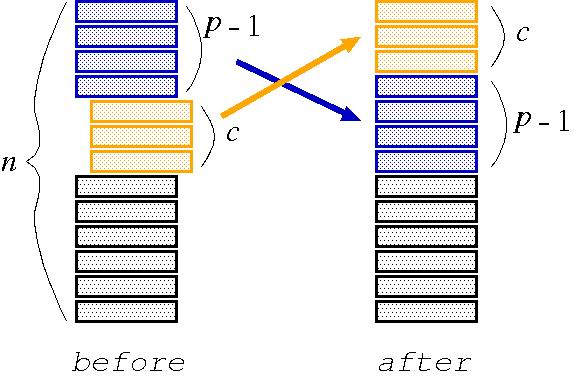当前你的浏览器版本过低,网站已在兼容模式下运行,兼容模式仅提供最小功能支持,网站样式可能显示不正常。
请尽快升级浏览器以体验网站在线编辑、在线运行等功能。
1978:Hanafuda Shuffle
题目描述
There are a number of ways to shuffle a deck of cards. Hanafuda shuffling for Japanese card game 'Hanafuda' is one such example. The following is how to perform Hanafuda shuffling.
There is a deck of n cards. Starting from the p-th card from the top of the deck, c cards are pulled out and put on the top of the deck, as shown in Figure 1. This operation, called a cutting operation, is repeated.
Write a program that simulates Hanafuda shuffling and answers which card will be finally placed on the top of the deck.

Figure 1: Cutting operation
There is a deck of n cards. Starting from the p-th card from the top of the deck, c cards are pulled out and put on the top of the deck, as shown in Figure 1. This operation, called a cutting operation, is repeated.
Write a program that simulates Hanafuda shuffling and answers which card will be finally placed on the top of the deck.

Figure 1: Cutting operation
输入解释
The input consists of multiple data sets. Each data set starts with a line containing two positive integers n (1 <= n <= 50) and r (1 <= r <= 50); n and r are the number of cards in the deck and the number of cutting operations, respectively.
There are r more lines in the data set, each of which represents a cutting operation. These cutting operations are performed in the listed order. Each line contains two positive integers p and c (p + c <= n + 1). Starting from the p-th card from the top of the deck, c cards should be pulled out and put on the top.
The end of the input is indicated by a line which contains two zeros.
Each input line contains exactly two integers separated by a space character. There are no other characters in the line.
There are r more lines in the data set, each of which represents a cutting operation. These cutting operations are performed in the listed order. Each line contains two positive integers p and c (p + c <= n + 1). Starting from the p-th card from the top of the deck, c cards should be pulled out and put on the top.
The end of the input is indicated by a line which contains two zeros.
Each input line contains exactly two integers separated by a space character. There are no other characters in the line.
输出解释
For each data set in the input, your program should write the number of the top card after the shuffle. Assume that at the beginning the cards are numbered from 1 to n, from the bottom to the top. Each number should be written in a separate line without any superfluous characters such as leading or following spaces.
输入样例
5 2 3 1 3 1 10 3 1 10 10 1 8 3 0 0
输出样例
4 4
最后修改于 2020-10-29 06:19:29 UTC 由爬虫自动更新
共提交 0 次
通过率 --%
| 时间上限 | 内存上限 |
| 1000 | 30000 |
登陆或注册以提交代码